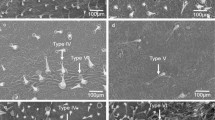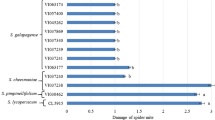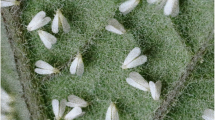Abstract
The silverleaf whiteflyBemisia argentifolii Bellows & Perring (Homoptera: Aleyrodidae) [also known as strain B of the sweetpotato whiteflyB. tabaci (Gennadius)] is a major pest of tomatoes due to both feeding damage and transmission of plant viruses. Certain wild species ofLycopersicon have demonstrated high levels of resistance to the pest. Greenhouse studies were undertaken to quantify the effects on whitefly behavior and mortality of individual, resistant plants selected from three accessions ofL. pennellii (Corr.) D’Arcy (LA 1340, LA 1674 and LA 2560), five accessions ofL. hirsutum f.typicum Humb. & Bonpl. (LA 386, LA 1353, LA 1777, PI 127826 and PI 127827) and one accession ofL. hirsutum f.glabratum C.H. Mull. (PI 126449). In no-choice experiments, fewer adults settled on leaflets of the wild species and deposited 75–100% fewer eggs compared to the cultivated tomato,L. esculentum Mill. Adult mortality ranged from 77–100% on wild accessions but was only 1% onL. esculentum. Most dead adults were trapped in glandular trichome exudates. The effects of these resistant accessions onB. argentifolii were mechanically transferable by appressing the trichome exudates onto the leaves of the susceptible tomato, indicating an association between the factors mediating the resistance and the glandular trichomes. Laboratory studies evaluated the repellent, fumigant and residual toxic effects of representative constituents of trichome exudates onB. argentifolii adults by using selected concentrations and probit analyses. RC50 values (estimated concentration to repel 50% of the adults) and LC50 values for fumigant and residual toxicity indicated that 2-tridecanone had low levels of repellent and residual toxicity activity; that 2-undecanone had high levels of repellent and fumigant activity; and that ginger oil (composed, in part, of sesquiterpene hydrocarbons) had high levels of repellent and residual toxicity activity. These studies suggest that multi-factor resistance exists in wild tomato germplasm. By combining genetically the observed chemical constituents of resistance into a single germplasm, the resulting resistance may be more difficult forB. argentifolii to overcome.
Similar content being viewed by others
References
Berlinger, M.J., Dahan, R. and Shevach-Urkin, E. (1983) Breeding for resistance in tomato to the tobacco whitefly (Bemisia tabaci).Phytoparasitica 11:132 (abstr.).
Burke, B.A., Goldsby, G. and Mudd, J.B. (1987) Polar epicuticular lipids ofLycopersicon pennellii.Phytochemistry 26:2567–2571.
Carter, C.D., Gianfagna, T.J. and Sacalis, J.N. (1989) Sesquiterpenes in glandular trichomes of a wild tomato species and toxicity to the Colorado potato beetle.J. Agric. Food Chem. 37:1425–1428.
Carter, C.D., Sacalis, J.N. and Gianfagna, T.J. (1989) Zingiberene and resistance to Colorado potato beetle inLycopersicon hirsutum f.hirsutum.J. Agric. Food Chem. 37:206–210.
Coates, R.M., Denissen, J.F., Juvik, J.A. and Babka, B.A. (1988) Identification of alpha-santalenoic and endo-beta-bergamotenoic acids as moth oviposition stimulants from wild tomato leaves.J. Org. Chem. 53:2186–2192.
Dahan, R. (1985)Lycopersicon pennellii as a source for resistance to the tobacco whiteflyBemisia tabaci in tomato. M.Sc. thesis, Ben-Gurion University of the Negev, Be’er Sheva, Israel (Hebrew, with English summary).
Denholm, I., Cahill, M., Byrne, F.J. and Devonshire, A.L. (1996) Progress with documenting and combating insecticide resistance inBemisia. pp. 577–603.in: Gerling, D. and Mayer, R.T. [Eds.]Bemisia: 1995 Taxonomy, Biology, Damage, Control and Management. Intercept Ltd., Andover, Hants, UK.
Dimock, M.B., Kennedy, G.G. and Williams, W.G. (1981) Toxicity studies of analogs of 2-tridecanone, a naturally occurring toxicant from a wild tomato.J. Chem. Ecol. 8:837–842.
Fobes, J.F., Mudd, J. and Marsden, M. (1985) Epicuticular lipid on the leaves ofL. pennellii andL. esculentum.Plant Physiol. 77:567–570.
Goffreda, J.C., Steffens, J.C. and Mutschler, M.A. (1990) Association of epicuticular sugars with aphid resistance in hybrids with wild tomato.J. Am. Soc. Hortic. Sci. 115:161–165.
Heinz, K.M. and Zalom, F.G. (1995) Variation in trichome-based resistance toBemisia argentifolii (Homoptera: Aleyrodidae) oviposition on tomato.J. Econ. Entomol. 88:1494–1502.
Kennedy, G.G. and Dimock, M.B. (1983) 2-tridecanone: A natural toxicant in wild tomato responsible for insect resistance. pp. 123–128.in: Miyamoto, J. and Kearney, P.C. [Eds.] International IUPAC Congress of Pesticide Chemistry. Pergamon Press, New York, NY.
Liedl, B.E., Lawson, D.M., White, K.K., Shapiro, J.A., Cohen, D.E., Carson, W.G.et al. (1995) Acylsugars of wild tomatoLycopersicon pennellii alters settling and reduces oviposition ofBemisia argentifolii (Homoptera: Aleyrodidae).J. Econ. Entomol. 88:742–748.
Lin, S.Y.H., Trumble, J.T. and Kumamoto, J. (1987) Activity of volatile compounds in glandular trichomes ofLycopersicon species against two insect herbivores.J. Chem. Ecol. 13:837–850.
Muigai, S.G. (1997) Enhancement of wildLycopersicon germplasm for resistance toBemisia argentifolii (Homoptera: Aleyrodidae). Ph.D. dissertation, University of Florida, Gainesville, FL, USA.
Perring, T.M., Cooper, A.D., Rodriguez, R.J., Farrar, C.A. and Bellows, T.S. Jr. (1993) Identification of a whitefly species by genomic and behavioral studies.Science 259:74–77.
SAS Institute. (1988) SAS/STAT User’s Guide. SAS Institute, Cary, NC, USA.
Sax, I.N. and Lewis, R.J. Sr. (1987) The Condensed Chemical Dictionary. Van Nostrand Reinhold, New York, NY.
Schuster, D.J., Funderburk, J.E. and Stansly, P.A. (1996) IPM in tomatoes. pp. 387–411.in: Rosen, D., Capinera, J.L. and Bennet, F.D. [Eds.] Integrated Pest Management — A Florida Perspective. Intercept Ltd., Andover, Hants, UK.
Schuster, D.J., Stansly, P.A. and Polston, J.E. (1996) Expressions of plant damage byBemisia. pp. 153–165.in: Gerling, D. and Mayer, R.T. [Eds.]Bemisia: 1995 Taxonomy, Biology, Damage, Control and Management. Intercept Ltd., Andover, Hants, UK.
Sharaf, N. (1986) Chemical control ofBemisia tabaci.Agric. Ecosyst. Environ. 17:111–127.
Shevach-Urkin, E. (1983) Comparison of the tobacco whitefly in the cultivated tomatoLycopersicon esculentum and wild speciesLycopersicon hirsutum f.glabratum. M.Sc. thesis, The Hebrew University of Jerusalem, Faculty of Agriculture, Rehovot, Israel (Hebrew, with English summary).
Snyder, J.C., Guo, Z., Thacker, R., Goodman, J.P. and St. Pyrek, J. (1993) 2,3-dihydrofarnesoic acid, a unique terpene from trichomes ofLycopersicon hirsutum, repels spider mites.J. Chem. Ecol. 19:2981–2997.
Snyder, J.C., Simmons, A.M. and Thacker, R.R. (1998) Attractancy and ovipositional response of adultBemisia argentifolii (Homoptera: Aleyrodidae) to Type IV trichome density on leaves ofLycopersicon hirsutum grown in three day-length regimes.J. Entomol. Sci. 33:270–281.
Soost, R.K., Scora, R.W. and Sims, J.J. (1968) Contribution to the chromatographic analyses of leaf oils in the genusLycopersicon.J. Am. Soc. Hortic. Sci. 92:569–571.
Weston, P.A., Johnson, D.A., Burton, H.T. and Snyder, J.C. (1989) Trichome secretion composition, trichome densities, and spider mite resistance of ten accessions ofLycopersicon hirsutum.J. Am. Soc. Hortic. Sci. 114:492–498.
Yorit, M. (1986) The wild speciesLycopersicon hirsutum Humb. & Bonpl. as a source for resistance to the tobacco whitefly (Bemisia tabaci Gennadius) in the cultivated tomatoLycopersicon esculentum Mill. M.Sc. thesis, The Hebrew University of Jerusalem, Faculty of Agriculture, Rehovot, Israel (Hebrew, with English summary).
Author information
Authors and Affiliations
Additional information
http://www.phytoparasitica.org
Rights and permissions
About this article
Cite this article
Muigai, S.G., Schuster, D.J., Snyder, J.C. et al. Mechanisms of resistance inLycopersicon germplasm to the whiteflyBemisia argentifolii . Phytoparasitica 30, 347–360 (2002). https://doi.org/10.1007/BF02979682
Received:
Revised:
Issue Date:
DOI: https://doi.org/10.1007/BF02979682




